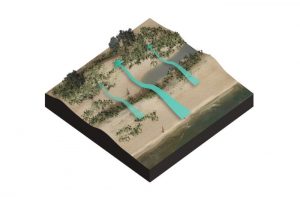Practical applications
In this ‘Practical applications’-section two examples are given of enhancing dune dynamics in an existing coastal dune system and the creation of a ‘new’ dune system. The lessons learned of these projects are described to give an idea of the challenges that were encountered. These examples are both of the Netherlands. Another example is that IUCN is within the WACA-program implementing Nature Based Solutions to counter coastal erosion in West Africa (WACA FFEM (in French)). This involves the stabilization of dunes by planting vegetation in different locations.
Enhancing dune dynamics in existing coastal dunes: Noordvoort (Netherlands)
European studies show that initiation of artificially induced foredune blowouts are the most successful and sustainable management measure for dune reactivation. This is due to the fact that foredune blowouts re-introduce interactions between the beach and the hinterdunes (Schwarz et al, 2018). An example of restoring dune dynamics in the Netherlands is project Noordvoort, North Holland, the Netherlands. Here, seventeen notches and blowouts were created in the foredune in 2013. The foredune had been stabilized in former dune management, reducing the natural value of the dune area. The objective of the project was to restore the interaction between the beach and the dunes, by enhancing dune dynamics in the foredune. The interventions consisted of removing vegetation and removing parts of the soil as start of the notches and blowouts.
Lessons learned
Some of these open spots required management to keep the vegetation from colonizing the notches and blowouts. The majority of the notches and blowouts (12 out of 17) are successful and become bigger due to erosion, leading to sand transport towards the hinterdunes. Five years after the intervention, effects on the vegetation composition are not yet visible. However, that was expected because that is a long-term process and can take many years. The effect on the diversity in landscape and geomorphology is evident. The project also makes the area more attractive for recreation, for which viewpoints were created in the dune landscape.

Enhancing dune dynamics in constructed dune: Hondsbossche Dunes (Netherlands)
The Hondsbosche Dunes (HBD) in the Netherlands is an example of coastal dune reconstruction. In the period 2014-2015, the Hondsbossche Dunes were constructed at the North Sea Coast of the Netherlands. The dunes replaced the flood defence function of the existing Hondsbossche and Pettemer sea dyke and became the new main flood defence, since the dike did not meet the safety standards anymore. The design of the Hondsbossche Dunes consists of a sandy shallow foreshore (the beach) and a varied artificial dune landscape that has the potential to develop in valuable natural habitats. Together, these connected systems make up the primary flood defence and provide the desired spatial quality.
Lessons learned
The total volume of sand blowing into the dunes is determined by the supply of dry sand from the beach rather than by the local geometry of the dune body itself. In other words, the local geometry has only impact on the cross-shore and alongshore distribution of the sediment transported by wind over the newly constructed geometry. On an average cross-shore profile, most of the sediment (70 %) was deposited on the seaward side of the foredune complex, mainly below the NAP+6 m level. The rest (25-30%) of the volume is deposited on the top of the dune, mainly on the seaward part. Only small amounts are deposited on the landward side of this first dune. In case dynamics are desired further landward, design measures can be optimised to stimulate transport of sand further into the dune area. In case of the HBD this was not desired.
The overall dune geometry can generally be optimised as well. Sand is mostly deposited in the lower parts of the profile, so a dune including a low dune on the seaward side creates a wider zone with sand deposits, creating a wider zone with dynamic development. On the other hand, from a Dutch safety perspective, a narrower, but initially a high dune is optimal, because the dunes increase very little in height after construction, so the anticipated dune level should be present from the start. In time, the aeolian deposits on the seaward side of the dune will lead to increased safety level (according to Dutch safety standards).
Based on the Dutch policy of coastal protection and the observed dune growth rates in the first three years after construction it is expected that the natural dune growth rate keeps pace with the rising sea level and subsidence up to 2050, maintaining the initial high safety level. Therefore, in the future for similar projects, it may be possible to achieve a volume reduction in the design by anticipating on the natural dune growth rate (but is location dependent). Since there is a large uncertainty in sea level rise scenarios, the need for additional nourishments in case of increased sea level rise, can still be assessed as part of the yearly monitoring programme and adaptive management, allowing for a flexible and adaptable coastal defence.


